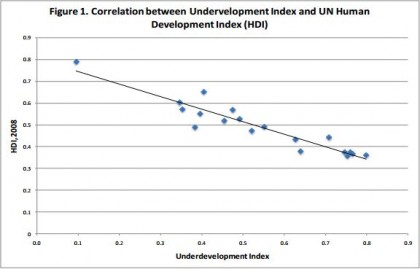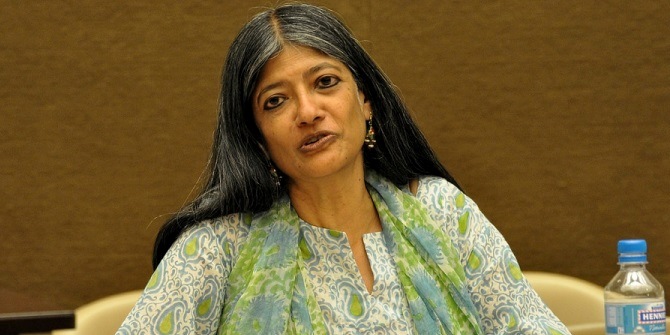Sanghamitra Bandyopadhyay argues that the recent report offers excellent insight on how to revise funds allocation to better represent Indian states’ socio-economic landscape.
The “Report for the Committee for Evolving a Composite Development Index of States” was published last month by the Ministry of Finance of the Government of India. The report, headed by the newly appointed Governor of the Reserve Bank of India, Dr Raghuram Rajan, has received heavy criticism from several fronts in India. It proposes a new index of “underdevelopment” using several socio-economic indicators, and proposes a ranking of the Indian states on the basis of their estimates of that index. The report also proposes revised fund allocations to the States from the central government on the basis of that index.
Politicians from several states disagree with the rankings of the Indian states in terms of their level of development. Some of the politicians from rich states are disappointed that the new index ranks them at a lower level than expected, with similar concerns from politicians from poorer states that have been ranked higher than expected. For example, the chief minister of Tamil Nadu strongly disagrees with the report’s ranking of Tamil Nadu being higher than what the Tamil Nadu government perceives. Likewise, the chief minister of Gujarat, Narendra Modi, has criticised the report for ranking Gujarat at a lower level than its usual top position.
These concerns stem from the fact that India has a federal system where state-level governments have independent power in formulating individual development policies at the state-level, but are also dependent upon funds from the central government. The more developed “tiger” states get higher rankings, and elicit fast-track development funding and special attention from the centre. However, the same states lose out on crucial funds that the centre is likely to regularly extend to lesser developed states. The criticism expressed by the numerous politicians has therefore reflected both ends of the spectrum.
While a currently functioning centre-to-state funds distribution algorithm, known as the Gadgil-Mukherjee (G-M) formula, already exists, there is global precedent to revise such formulae subject to new circumstances. The UK equivalent of the G-M formula is known as the Barnett formula, and is used by the UK Treasury for devolution of public expenditures in the UK. It has also been heavily criticised for being outdated, especially on the grounds that it gives undue preference to Scottish regions. It should thus come as no surprise that the new Rajan panel report has resulted in such uproar.
But is there truly an anomaly in the report’s rankings? Do states’ ranks deviate from what research suggests they ought to be? The short answer is that the rankings are quite consistent with what recent research has uncovered.
There are some significant differences in how academic research has estimated the rankings of Indian states compared to what is undertaken in the report. Typically, due to the availability of high quality data and a longer time series, researchers tend to use state-level GDP or income per capita to measure development. The Rajan panel report, however, uses household-level consumption expenditure instead. The report is correct to argue that household-level consumption is a more accurate indicator of individual well-being than aggregated GDP statistics.
Moreover, the estimated index is an aggregate of up to 10 socio-economic indicators covering crucial areas of health and education. Indeed, it is frequently argued in the economics literature – as well as stressed by World Bank and UN reports – that individual wellbeing is more a function of a large array of socio-economic “capabilities” rather than just income or consumption. One can question the method of aggregation used to compile the index using the several socio-economic indicators, as is typically done in the economics literature, but the method employed is simple enough to draw relatively accurate first-hand estimates.
All said, state-level rankings generated by most recent studies using state GDP as the unit of measurement (for example, see here and here) almost perfectly match with rankings generated by the report. Most importantly, the top performing states and the lowest performing states are the same for both the report and the above studies – Punjab, Haryana, Gujarat, and Maharashtra in the former category and Bihar, Orissa and Rajasthan in the latter. However, the middle ranked states tend to vary every few years, and are quite mobile in their relative rankings. States such as Karnataka, Tamil Nadu and Andhra Pradesh are the new rising powers, and are reflected in the report quite clearly. Similarly, states such as West Bengal which have languished since the 1970s until the early 1990s, have picked up in the last decade, a fact that is also clearly reflected in the ranking proposed by the report.
One contentious issue is that the estimated allocations of funds vary from what the traditional G-M formula would predict. Given that the allocation of funds is determined by both the level of the underdevelopment index and their population and area, the larger states will now obtain higher allocations. The final share of funds allocated to each State is dependent not only on the G-M formula but also on other resource allocation mechanisms (such as those from the Finance Commission and centrally sponsored schemes). However, on a per capita basis, the variation in allocated funds appears to be similar to those accorded by the earlier formula.
In short, the report provides an excellent insight on how the allocation of funds can be revised with a more accurate representation of the states’ socio-economic landscape. The Indian Ministry of Finance ought to be commended on its efforts for devising its new index of underdevelopment.
For more information on states’ income and development, see:
Bandyopadhyay, S. (2011): Rich States, Poor States: Convergence and Polarisation across Indian States, Scottish Journal of Political Economy, 57(3), June 2011: 414-436.
Bandyopadhyay, S. (2013): “Convergence Clubs in Incomes across Indian States: Is There Evidence of a Neighbours’ Effect?”, Economics Letters, 116, 565-570, 2012.
Dr Sanghamitra Bandyopadhyay is a Research Associate at STICERD at LSE and Senior Lecturer in Economics at Queen Mary, University of London.








